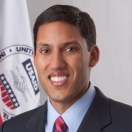
Ed. note: On March 11, 2009, President Obama established the inter-agency White House Council on Women and Girls to ensure the programs and policies of the federal government are being crafted and implemented with the wellbeing of our women and girls at the forefront of our thinking and priorities. This post is part of a month-long series highlighting government-wide progress toward that goal. Read more posts here.
Last spring, I visited Burma for the first time and met Dr. Aye Aye Mu. She is dedicating her life to serving vulnerable women and children by working closely with individual doctors to improve the equality and accessibility of their life-saving care.
In a country where 35 percent of all children suffer from stunting, Dr. Aye Aye’s work has saved countless lives. Last year alone, she conducted over 5,000 reproductive health consultations and treated more than 250 cases of tuberculosis. An innovative and dedicated physician, Dr. Aye Aye Mu embodies our Agency’s commitment to ensuring that everyone everywhere enjoys the opportunity to live to her full potential.
From Burma to Afghanistan to Senegal, I have seen the profound impact that our investments in women and girls can have—from empowering women during political transitions to helping end the outrage of child death. If we are going to truly achieve the goal of ending extreme poverty by 2030, we cannot leave behind half of the global population. We have to invest in women and girls as champions of development who can lift their families out of extreme poverty.
Across our projects in more than 80 countries, we are doing just that—by making evidence-based investments in gender equality and female empowerment.
Through President Obama’s Feed the Future initiative, we’re focusing on women’s leadership in agriculture by advancing policy changes in developing countries that give women access to financial services and ownership of the very land they tend. Indeed, we’ve seen that just by giving women equal access to land, new technologies or sources of capital, we can increase food production by as much as 30 percent and feed an additional 150 million people.
In sub-Saharan Africa—where half of all maternal deaths occur—we are leading the public-private partnership Saving Mothers, Giving Life. Just one year after launching in Uganda and Zambia, the program reduced maternal mortality by roughly a third.
And in Afghanistan, the Promoting Gender Equality in National Priority Programs (PROMOTE) Partnership will be the largest investment we have ever made to advance women and girls in development. Over five years, we will directly reach 75,000 women—thus increasing women’s contributions to Afghanistan’s development by strengthening women’s rights groups, boosting female participation in the economy, increasing the number of women in decision making positions within the Afghan government, and helping women gain business and management skills. Across the world, our work is grounded in the fundamental principle that investing in women and girls delivers exponentially greater dividends for peace, security, and prosperity.
As President Obama said last year, “When women succeed, nations are more safe, more secure, and more prosperous.” We will continue to work with partners to expand opportunities for women throughout the world—in hospitals, classrooms, governments, markets and boardrooms. I hope that you’ll join the nearly 10,000 staff members of USAID in celebrating—and advancing—the incredible potential of women each and every day during Women’s History Month.
Click here for fuller list of accomplishments from across the administration.
Rajiv Shah is the Administrator of the U.S. Agency for International Development


